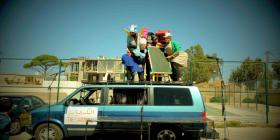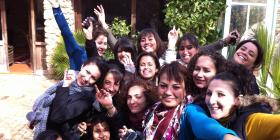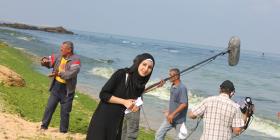Syria: protecting the cradle of world culture

The chaos in Syria today is an imminent danger to the cultural heritage of the country. Concrete measures are taken by international bodies to fight against looting, destruction and illicit trafficking.
Since the outbreak of the conflict in Syria, UNESCO has continued its actions to protect the Syrian cultural heritage. Several calls and projects have been launched and several training and awareness workshops were organised to collect and disseminate information on looting and illicit trafficking[1]. Similarly, UNESCO had organised from the 26th to the 28th May 2014, with funding from the EU and the support of the Flemish government, an international meeting entitled "Rallying the international community to safeguard Syria's cultural heritage"[2]. This meeting was held in closed session at the UNESCO headquarters in Paris in the presence of more than 120 experts from 22 countries[3] who participated in their personal capacity and in light of their expertise in the protection of heritage. The latter is devastated by conflict and illicit trafficking of cultural property.
Among the decisions taken was the creation of an Observatory in Beirut that would report on the state of the Syrian cultural heritage and would collect the information needed to restore it, once the conflict is over. It would have an online platform allowing decision makers to share information on damaged structures, looted objects and all kinds of danger that is threatening this heritage.
Syria and Iraq: UNESCO Conference calls for the creation of protected cultural areas
The Director-General of UNESCO, holding a more categorical position, called for the creation of ''cultural protection zones" around the heritage sites starting with the Great Umayyad Mosque of Aleppo. She mentioned this at the opening of the International Conference on the threats to cultural heritage and diversity in these two countries. This meeting was held at the UNESCO Headquarters on the 5th December 2014 in the presence of more than 500 policy makers, museum curators, academics and experts.
Among the measures requested were the need to fight against illicit trafficking of cultural property described by the UNESCO DG as "a strategy of deliberate cultural cleansing of exceptional violence", and the implementation of the Convention for the Protection of Cultural Property in the Event of Armed Conflict of 1954 and its additional protocols, in order to end the impunity of deliberate attacks against cultural heritage, recognised as a war crime under the Rome Statute of the International Criminal Court.
It is mentioned here that several Syrian historical sites have been put on the list of World Heritage in Danger in order to mobilise all possible support and to ensure their preservation.
Along the same lines, the ICOM (International Council of Museums) published the Emergency Red List of Syrian Cultural Objects at Risk in order to help heritage professionals and law enforcement agencies identify Syrian objects that are protected by national and international legislation.
Several international organisations have also taken concrete measures to fight against these practices[4].
But the damage caused by the war is not limited to sites and buildings. Sarab Atassi, scientific secretary of the French Institute for the Near East in Damascus, expressed concern about the fund and the archives of the IFPO as well as the results of the research and documentation work carried out over many years by its teams. As an example she mentions the "prospecting activities and study of the historical city of Damascus leading to an elaborate system of data logging based on the cadastre of the 30s, and on a land survey". Hundreds of documents, thousands of photographs, have been grouped and stored in order to make a computerised catalogue to be placed online. This effort is not limited to the inner city, but also includes the extramural historical suburbs dating from the Ayyubid and Mamluk eras and more recently the mandate era.
This hard work is only part of the research conducted by the IFPO over many years. But what should be done to protect and perpetuate this work? Sarab Atassi explained that the scientific publication of threatened sites has become an essential requirement, as well as the creation of a geo-referenced database of the Syrian archaeological heritage, according to UNESCO guidelines. At the moment it is difficult to develop the research that has been started because people are scattered and it is difficult to access the work documents. But with a little efficient organisation, it would be possible to recover and exploitall this documentation. In two recent visits to Damascus, Sarab Atassi was able to save computer files about her work in the Atelier du Vieux Damas, including the research she conducted with a team about traditional hammams[5]. All of this (plans, maps, readings, photographic coverage, documentaries) is kept at the IFPO in Beirut.
This account by Sarab Atassi mentions only part of the risks threatening the research and documentation work that lasted so many years. But it is also an excellent example of the willingness of individuals and institutions to continue in spite of everything, in the hope of saving the history of this country, the cradle of civilisations.
Hanan Kassab Hassan
Content produced in collaboration with Babelmed
[1]In addition to a page on the UNESCO website to disseminate and renew information about illicit trafficking of Syrian cultural property and to promote regional cooperation against this trafficking, 2 regional workshops were organised on the same theme by the UNESCO Office in Amman (10-13 February 2013 and 3-5 December 2013). The launch of a 3-year project from March 2014 entitled EU-UNESCO is also mentioned: Emergency Safeguarding of Syrian Cultural Heritage project with funding from the UE and in collaboration with ICOMOS and ICROM and other strategic partners.
[2] This meeting is part of a 2.5 million euro project of the European Union, entitled "Emergency Safeguarding of Syrian Cultural Heritage", which the UNESCO Office in Beirut has been implementing since March 2014.
[3]Among these experts are specialists in Syrian cultural heritage and the Syrian diaspora, archaeologists, representatives of Syrian NGOs and institutional partners of UNESCO, as well as university professors of the Middle East and elsewhere. Representatives of the major international auction houses also attended the meeting.
[4]A list of initiatives taken by 38 international bodies with a remarkable outcome is published by Silvia Perini and Emma Cunliffe in Towards a protection of the Syrian cultural heritage: A summary of the international responses (March 2011 - March 2014). The book is published in collaboration with Heritage for Peace, Catalonia, Spain. contact@Heritageforpeace.org Silvia Perini: s.perini@sms.ed.ac.uk.
[5]This is an interdisciplinary research on bathhouses in Damascus as part of an EU project in cooperation with OIKODROM, the Vienna Institute for Urban Sustainability, and pursued in the framework of the programme Hammamed//Euromed Heritage IV ( 2008-2011). A rich documentation was collected and partially distributed through many participatory activities, exhibitions, documentaries and publications.







